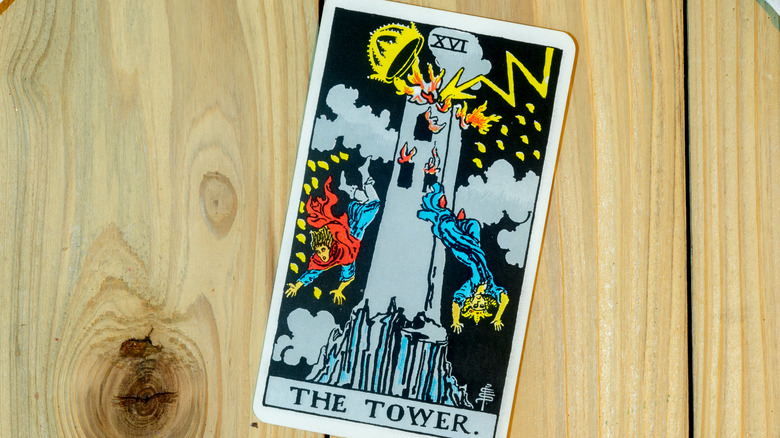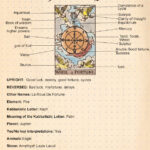In the intricate tapestry of Tarot, the Tower card stands out with a resonance that evokes both fear and enlightenment. When viewed through a Christian lens, its interpretations can be both troubling and enlightening, merging the symbols of divine intervention and human frailty into a singular narrative of transformation.
The Tower: A Symbol of Upheaval
At first glance, the Tower card, often depicted as a crumbling edifice struck by divine lightning, might suggest catastrophic destruction. In Christian symbolism, this tower resonates with the proverbial Tower of Babel—a majestic structure built to reach the heavens, which ultimately led to disarray and confusion. The falling individuals represent humanity’s hubris, a stark reminder that pride often precedes a fall, as echoed in Proverbs 16:18: “Pride goes before destruction, a haughty spirit before a fall.”
In essence, the Tower embodies the notion of divine judgment, an inevitable tearing down of false structures that no longer serve. This demolition, while painful and unsettling, is necessary for reformation. It reflects the purging of sin and spiritual stagnation, laying the groundwork for a rebirth.
Divine Intervention: The Hand of God
The striking bolt of lightning that cleaves the Tower serves as a potent metaphor for divine intervention. It emphasizes the omnipotence of God, who can disrupt the flow of human existence at will. This is reminiscent of the story of Jonah, who found himself in the belly of a fish, diverted from his path by a dramatic act of divine will. The Christian perspective holds that such disruptions are not merely chaotic events but are orchestrated for a higher purpose.
In this light, the Tower card invites believers to recognize disruptions in their lives as potential opportunities for spiritual awakening. Like the tumultuous seas calmed by Jesus, the violent disintegration of one’s life circumstances can eventually yield tranquility and clarity. The destruction at hand urges a relinquishment of control, allowing for a deeper, more profound connection with the divine.
Transformation Through Suffering
Another layer of meaning within the Tower card is the concept of transformation, particularly through suffering—a theme prevalent in Christian teachings. Suffering is often depicted in scripture as a means of refining character and fostering a deeper relationship with God. Just as the Tower collapses, a believer might find themselves stripped of worldly attachments, leading to an awakening of the spirit.
This mirrors the biblical narrative of Job, who underwent immense suffering but ultimately found his faith tested and fortified. In experiencing loss, believers often discover resilience and a more profound sense of faith, allowing them to emerge from despair with newfound wisdom and strength. The Tower, therefore, signifies a divine invitation to face adversity head-on, trusting that it will lead to greater enlightenment and inner peace.
The Gift of Revelation
Interestingly, the Tower card also represents revelation, shedding light on truths that may have been obscured in the fog of complacency. In Christianity, this revelation can be likened to moments of epiphany, where the scales fall from one’s eyes, enabling clarity in spiritual matters. The blinding light of the Tower’s destruction may unveil stagnant beliefs or practices that require reevaluation, pushing an individual toward genuine faith rather than mere ritual.
This act of divine revelation serves not only to cleanse but also to guide. It encourages individuals to discern between the transient and the eternal, urging a focus on salvation and spiritual growth. As stated in James 1:5, “If any of you lacks wisdom, let him ask of God, who gives to all liberally and without reproach, and it will be given to him.” The Tower can thus be seen as a catalyst for seeking divine wisdom in the face of chaos.
Hope Amidst Ruin
Amidst the chaos of the Tower card lies an underlying current of hope. The destruction of old structures often paves the way for new beginnings. Much like the resurrection narrative, which is central to Christian belief, the dismantling of the Tower is not an end but a prelude to rebirth and renewal. This encourages an attitude of resilience; understanding that what appears to be ruin is merely the opportunity for a resurrection of a higher state of being.
This theme of hope reaffirms the belief that God is ever-present, even in the darkest moments. It evokes the reassurance found in Psalms 30:5: “For his anger lasts only a moment, but his favor lasts a lifetime; weeping may stay for the night, but rejoicing comes in the morning.” The Tower, therefore, beckons believers to hold steadfast during tumultuous times, promising that joy shall rise from the ashes.
Conclusion: Embracing the Lessons of the Tower
The Tower card serves as a profound reminder that life’s upheavals can lead to divine clarity, transformative suffering, and ultimately to hope. Viewed through a Christian perspective, it compels believers to confront instability with courage and faith, acknowledging that divine intervention often catalyzes profound change. In navigating the trials of the Tower, one can emerge enlightened, with a renewed perspective on faith and resilience, embodying the journey from destruction to divine grace.










Leave a Comment